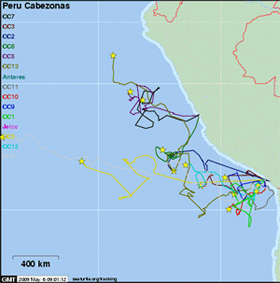Sea Turtle
Mortality rate in each of the life stages, but especially during the aquatic stages, have been identified as a critical aspect of sea turtle research by the Global Strategy for the Conservation of Sea Turtles (IUCN, 1995).
In Peru, together with the lack of education of fishing and coastal communities, the main threats to turtles are mortality fisheries (bycatch), and habitat degradation and pollution.
In 2001, Pro Delphinus started a systematic assessment of turtle bycatch along the Peruvian coast. This study has provided valuable information on the species composition and mortality rates of sea turtles in artisanal longline fisheries.
Our satellite tracking project is the first telemetry study of loggerhead turtles in the southeastern Pacific Ocean. The presence of loggerheads in this region was only recently verified. “Cabezona” (big head) or “Amarilla” (yellow) are the local names for this species. The goal of this study is to improve our understanding of loggerhead habitat use, migration and foraging patterns in the southeastern Pacific. So far we have released 15 loggerhead turtles with satellite transmitters.

The goal of our educational program is to reach out to the next generation of fishermen in the ports with high levels of sea turtle mortality and human consumption of turtles. We aim to provide them with information and tools they need to make informed decisions regarding sea turtle conservation. Currently, Pro Delphinus continues to monitoring several ports along the Peruvian coast in collaboration with Oregon Zoo, International Fund for Animal Welfare (IFAW), Idea Wild, National Oceanic and Atmospheric Administration (NOAA), Nature and Culture and the National Fish and Wildlife Foundation (NFWF).